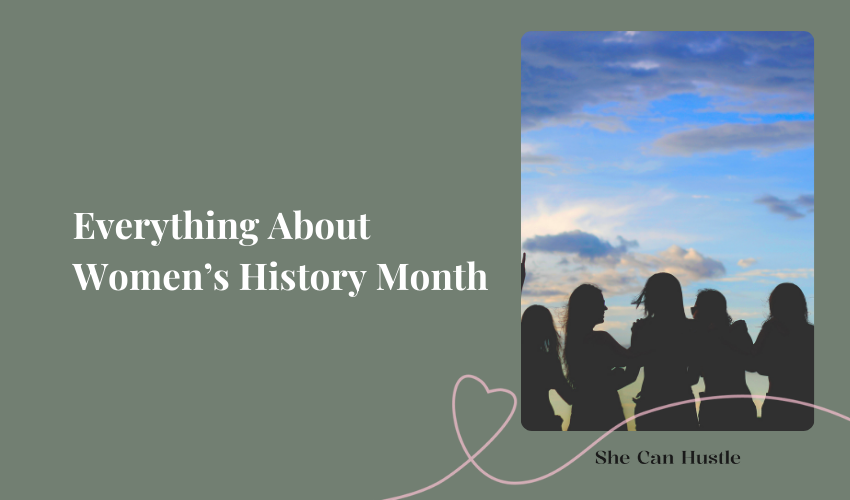It is a heartening trend that we see today when there is more than one reason to celebrate women from all walks of life.
As women started to make their mark as astute entrepreneurs, the world marked a day to celebrate them as powerful women making their presence known. Now, the world comes together to celebrate Women’s History Month and here we tell you more about it.
What is Women’s History Month
Women’s History Month is a celebration of women’s contribution to US history, culture, and society. It has been an annual celebration in the United States all through the month of March, since 1987.
It grew out of a weeklong celebration of women’s contributions to history, culture, and society organized by the school district of Sonoma, California way back in 1978. A parade was held in downtown Santa Rosa, presentations were given at dozens of schools, and hundreds of students participated in a “Real Woman” essay contest.
The idea caught everyone’s attention – within communities, school districts, and organizations across the country.
In the year 1980, President Jimmy Carter declared the week of March 8 as National Women’s History Week through a presidential proclamation. The following year, the U.S. Congress passed a resolution for holding it as a national celebration. Six years hence, the National Women’s History Project petitioned Congress to expand the event to the entire month of March.
Women’s History Month started from a day and grew into a week and then a month.
When is women’s history month
Women’s History Month is observed in March to celebrate women’s accomplishments and their significant personal and societal roles.
The month-long celebration started out as just International Woman’s Day on February 28, 1909 – a day that commemorated the meeting of socialists and suffragists in Manhattan.
A year later, on March 8, 1910, Clara Zetkin, a German activist suggested that International Women’s Day be recognized at an International Conference of Working Women in Copenhagen with attendees from 17 countries.
Everyone agreed and the first International Women’s Day was celebrated on March 8, 1911, in Austria, Switzerland, Germany, and Denmark.
The event started to get sponsored by the United Nations in 1975. It was in 1977 that a task force in California created Women’s History Week. By 1987, Congress declared the entire month of March Women’s History Month.
Why do we celebrate Women’s History Month
The month-long celebration is a way to reflect on the lives and journeys of women who have become the face of change.
Be it in the field of science, politics, or entertainment, it is dedicating a few days to remembering their formidable strength in engineering changes in our society and culture.
- Recognition: The month of March is to honor the achievements and contributions of those women who struggled for gender equity in the United States, irrespective of their backgrounds. This month dedicated to women has now spread all over the globe to pay tribute to those who dedicated their lives to the cause of equal rights for women.
- Education: It encourages learning about key figures and movements in women’s history. This helps to spread awareness and instill hope as women move forward battling societal pressures and cultural anomalies.
- Inspiration: It motivates current and future generations to pursue their goals and advocate for gender equality. The world is a place that offers equal growth to all and sundry, irrespective of gender or background.
Key themes and figures in Women’s History Month
Each year, Women’s History Month has a designated theme. Past themes have included “Valiant Women of the Vote” and “Women Providing Healing, Promoting Hope21”, and in 2024 “Women Who Advocate for Equity, Diversity, and Inclusion”.
- Sojourner Truth: Formerly enslaved, she became an advocate for abolition, alcohol temperance, and civil and women’s rights in the nineteenth century. Her zealous work got her an audience with President Abraham Lincoln in 1864. She helped recruit black troops for the Union Army, during the Civil War.
Later, she tried albeit unsuccessfully to secure land grants for formerly enslaved people from the federal government. She continued to fight on behalf of women and African Americans until her death. Her most famous speech “Ain’t I a woman?” spoke of her as a laborer capable of working just as hard as men being the reason for her to demand equal rights for her and all women. - Marie Curie: Pioneering scientist and Nobel Prize winner, she was born in Warsaw, Poland. She is remembered for her discovery of radium and polonium, and her considerable contributions to finding cancer treatments. She was the first woman to receive a Nobel Prize and the first to receive two Nobel Prizes.
Given the fact that the harmful effects of radiation were not fully understood back in her time, she died of radiation-induced leukemia in 1934. She remains a legend and an inspiration to this day for women who aspire to do pioneer work in the fields of science and research. - Rosa Parks: Her refusal to give up her bus seat to a white man in Montgomery, Alabama became the start of the Montgomery Bus Boycott by 17,000 black citizens. She is rightly called ‘ the mother of the civil rights movement’.
She worked tirelessly against racial segregation and collaborated with the likes of Martin Luther King Jr. - Malala Yousafzai: Education activist and youngest Nobel laureate, she became an international symbol of the fight for girls’ education when she was shot at by the Taliban for opposing their restrictions on female education in her home country of Pakistan, back in the year 2012.
She is an advocate for education for women and gender equality. “One child, one teacher, one pen, and one book can change the world’’, she said. “Books, not bullets,” are her words to the world leaders. From setting up the Malala Fund to opening schools for girls to having a ‘Malala day’ this young Pakistani activist continues to inspire millions of women across the world with her stories of fearlessness and stoicism. - Chimamanda Ngozi Adichie: This modern feminist and author from Nigeria became popular for telling stories of hope and pain civilians experience during war, and for her demanding equality of men and women. Her first novel, ‘Purple Hibiscus’, won the Commonwealth Writers’ Prize, and her second novel, ‘Half of a Yellow Sun’, won the Orange Prize.
Her stories are inspiring, delving into themes such as power, the powerlessness of women, and how they can reclaim that power by getting a better understanding of their identity apart from stories about the effects of war and other conflicts, both on large groups of people and individuals.
Ways to Celebrate Women’s History Month
Here are some ways to celebrate the month:
Individuals
- Read and Learn: Explore books, articles, and documentaries about women’s history. Organize talk shows, debates, essay writing competitions, speech sessions, panel discussions, and book signing/ reading sessions with those who speak eloquently about issues that concern women. Playing movies and documentaries that educate and walk people through the struggles of women across the globe, through special screenings is hugely informative.
- Support Women-Owned Businesses: Make conscious purchasing decisions. Speak of and encourage women-driven businesses, both big and small. It is good to build on a community of women who aspire to make their novel ideas of running their own businesses and find a similar audience and patrons who are willing to mentor and support them.
- Advocate: Volunteer at or donate to organizations supporting women’s rights. Join their campaigns to educate, and upskill girls/ women, or run employment drives to find suitable jobs for them, organize seminars that tell them about their strengths and how to deal with challenges in their lives, show them how to be seen and heard for reasons close to their heart and calling.
Schools
- Host Events: Organize talks, exhibitions, or assemblies focusing on influential women. Do all of this regularly, fixing days in a week or a month dedicated to celebrating women. Ask for women of acclaim to come as guest speakers to inspire young minds. Encourage talk and discussion-based activities to help women shed their inhibitions and speak as one.
- Integrate Curriculum: Include lessons on women’s contributions across disciplines. Sadly, most books on history have none to sketchy mentions of the roles women have played in the pivotal revolutions that have changed the way the world functions.
- Encourage Creativity: Assign projects like essays or art pieces celebrating women’s achievements. Organize painting competitions that bring women-centric themes onto a canvas. Arrange for dance and music-based cultural festivals that celebrate womanhood.
Organizations
- Highlight Women Leaders: Feature stories of women leaders within the company or industry. Hold talk sessions and encourage everyone to share their thoughts. Make the workspace gender-neutral and put such practices in place that encourage the same. Hold sessions on soft skills for all employees. Treat all with parity and base judgments on merit.
- Host Panel Discussions: Bring together diverse voices to discuss challenges and triumphs. Let everyone get a chance to speak of what they think is working for them and what could be adversely affecting their work output and individual growth.
- Promote Mentorship: Pair employees for professional development. This helps promote teamwork as well as boosts healthy competition. Employees get to learn from each other’s strengths and experiences. This also helps to prepare ordinary people into leaders.
Conclusion
Women have had a checkered history. Each part of their struggle deserves a mention and days that commemorate their journeys. Women’s History month is one such event that needs to spill into all parts of the world where it’s not observed to make all women know that they are noticed, applauded, and encouraged, irrespective of their social and cultural background.
Subscribe to She Can Hustle to bring more such interesting deets to your readings. Stay tuned for more!


